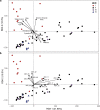Biogeochemical and historical drivers of microbial community composition and structure in sediments from Mercer Subglacial Lake, West Antarctica
- PMID: 36717625
- PMCID: PMC9886901
- DOI: 10.1038/s43705-023-00216-w
Biogeochemical and historical drivers of microbial community composition and structure in sediments from Mercer Subglacial Lake, West Antarctica
Abstract
Ice streams that flow into Ross Ice Shelf are underlain by water-saturated sediments, a dynamic hydrological system, and subglacial lakes that intermittently discharge water downstream across grounding zones of West Antarctic Ice Sheet (WAIS). A 2.06 m composite sediment profile was recently recovered from Mercer Subglacial Lake, a 15 m deep water cavity beneath a 1087 m thick portion of the Mercer Ice Stream. We examined microbial abundances, used 16S rRNA gene amplicon sequencing to assess community structures, and characterized extracellular polymeric substances (EPS) associated with distinct lithologic units in the sediments. Bacterial and archaeal communities in the surficial sediments are more abundant and diverse, with significantly different compositions from those found deeper in the sediment column. The most abundant taxa are related to chemolithoautotrophs capable of oxidizing reduced nitrogen, sulfur, and iron compounds with oxygen, nitrate, or iron. Concentrations of dissolved methane and total organic carbon together with water content in the sediments are the strongest predictors of taxon and community composition. δ¹³C values for EPS (-25 to -30‰) are consistent with the primary source of carbon for biosynthesis originating from legacy marine organic matter. Comparison of communities to those in lake sediments under an adjacent ice stream (Whillans Subglacial Lake) and near its grounding zone provide seminal evidence for a subglacial metacommunity that is biogeochemically and evolutionarily linked through ice sheet dynamics and the transport of microbes, water, and sediments beneath WAIS.
© 2023. The Author(s).
Conflict of interest statement
The authors declare no competing interests.
Figures





References
-
- Fricker H, Scambos T, Bindschadler R, Padman L. An active subglacial water system in West Antarctica mapped from space. Science. 2007;315:1544–8. - PubMed
-
- Livingstone S, Li Y, Rutishauser A, Sanderson R, Winter K, Mikucki J, et al. Subglacial lakes and their changing role in a warming climate. Nat Rev Earth Environ. 2022;3:106–24.
-
- Tulaczyk S, Mikucki J, Siegfried M, Priscu J, Barcheck C, Beem L, et al. WISSARD at Subglacial Lake Whillans, West Antarctica: scientific operations and initial observations. Ann Glaciol. 2014;55:51–8.
-
- Priscu J, Achberger A, Cahoon J, Christner B, Edwards R, Jones W, et al. A microbiologically clean strategy for access to the Whillans Ice Stream subglacial environment. Antarctitc Sci. 2013;25:637–47.

